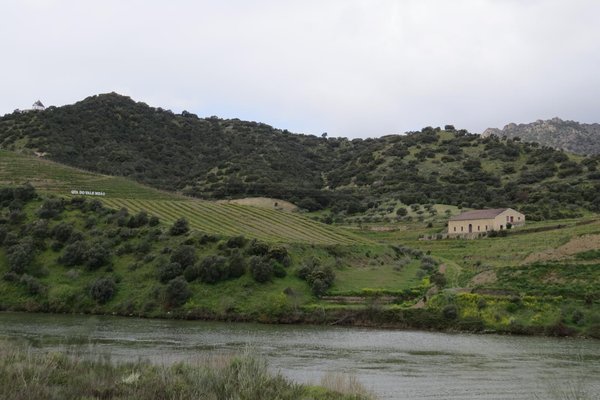Portugal
Alto Douro
The Alto Douro Wine Region comprises a landscape where the river banks and hillsides are transformed by viticulture.
The cultural landscape consists of terraced vineyards on large and small estates, white-walled villages, olive and almond crops, and the river Douro. Mainly, Port wine, defined and regulated since 1756, is produced here. Because of the hot, dry microclimate, growing conditions for grapes are ideal and winegrowing started as early as the 3rd century AD.
Community Perspective: although the landscape is generally pretty, it can be hard to visit something tangible related to the OUV. Echwel and Hubert recommend the area between Pinhao and Peso da Regua, with highlights such as the Museo Douro, a boat tour and Quinta do Bomfim. Ilya added a couple more quintas to consider.
Site Info
Official Information
- Full Name
- Alto Douro Wine Region (ID: 1046)
- Country
- Portugal
- Status
-
Inscribed 2001
Site history
History of Alto Douro
- 2001: Advisory Body overruled
- ICOMOS wanted referral because of management plan
- 2001: Inscribed
- Inscribed
- Type
- Cultural
- Criteria
- iii
- iv
- v
Links
- UNESCO
- whc.unesco.org
- Official
-
- visitportugal.com — Visit Portugal: Alto Douro
All Links
UNESCO.org
- whc.unesco.org — whc.unesco.org/
Official Website
- visitportugal.com — Visit Portugal: Alto Douro
News Article
- May 9, 2016 globalvoices.org — A New Dam in Portugal Is About to Destroy Parts of a World Heritage Wine Region
Community Information
- Community Category
- Human activity: Agriculture
- Cultural Landscape: Continuing
Travel Information
North Portugal hotspot
Recent Connections
-
Boats
Rabelo boat: "a traditional Portuguese … -
Depicted in Mizielinska Maps
VineyardsSee i.pinimg.com
-
Olive Tree Landscapes
"The property is an outstanding example…
Connections of Alto Douro
- Geography
-
-
Linear inscriptions
see map in nom file
-
- Trivia
-
-
Depicted in Mizielinska Maps
VineyardsSee i.pinimg.com
-
On Passports
Portuguese passportSee www.pep.pt
-
- Architecture
-
-
Glazed tiles
Estação Ferroviária do Pinhão
-
- Damaged
-
-
'Threatened' by Dams
Foz Tua Hydro-Electric Dam project
-
- Human Activity
-
-
Olive Tree Landscapes
"The property is an outstanding example of a unique relationship between man and the natural elements. Here, in spite of nature’s hostility to human settlement, man adapted Mediterranean crops, particularly vines and olive and almond trees, and planted them on the terraces he fashioned from the steep rocky slopes. Changes in the several methods employed over the centuries are evident in the landscape" (OUV crit iv) -
Man-made Terraces
patamares -
Boats
Rabelo boat: "a traditional Portuguese wooden cargo boat that was used for centuries to transport people and goods along the Douro River."See en.wikipedia.org
-
Vineyards
-
- Constructions
-
-
Railways
the construction of the Douro railway line (1873-87) encouraged this expansion (AB ev)
-
- WHS on Other Lists
- Timeline
-
-
Built in the 1st century
"Seeds of Vitis vinifera have recently been found at the 3-4 thousand year old Buraco da Pala Chalcolithic archaeological site near Mirandela. However, the more significant relics of viticulture and winemaking that have been uncovered date to the Roman occupation and particularly to the end of the Western Empire (3rd and 4th centuries AD). At the beginning of the Christian era, the Romans redefined all the land-use and restructured the economic activities in the entire valley of the Douro. From the 1st century onwards, they either introduced or promoted cultivation of vines, olive trees and cereals" (AB)
-
- WHS Hotspots
-
-
North Portugal hotspot
North Portugal Hotspot
-
- WHS Names
-
-
Named after a River
Douro
-
News
- globalvoices.org 05/09/2016
- A New Dam in Portugal Is About to …
Recent Visitors
Visitors of Alto Douro
- AC
- Adam Hancock
- Albert
- Alberto Rodriguez Gutierrez
- alex
- Alexander Lehmann
- Alexander Parsons
- alicemears
- ALS
- Alvaro1404
- Ammon Watkins
- AmyAbroad
- amychemu
- Ana Lozano
- andyng-site
- Anna Wludarska
- anthonybonbon
- Argo
- arnaugir
- Aspasia
- Atila Ege
- Axel Hansson
- AYB
- Bauchat
- BaziFettehenne
- Bill Maurmann
- Bin
- brornt
- Bruno_Pires
- Can SARICA
- Catoplayer
- Celina Nanbara
- Cezar Grozavu
- Cheryl
- Chinmaya
- Christoph
- Christravelblog
- Claire Bradshaw
- Clyde
- Cristina Erba
- Csaba Nováczky
- CugelVance
- cwthong
- Cyberczar
- Dani Cyr
- Daniela Hohmann
- Daniel Gabi
- Dan Pettigrew
- David Berlanda
- DavidS
- debatecoach
- Dimitar Krastev
- Dimitrios Polychronopoulos
- disnsam
- Dorejd
- Doubanjiang
- Dr. Caligari
- Dwight Zehuan Xiao
- Echwel
- Elia Vettorato
- eljx1988
- Els Slots
- Emilia
- Errol Neo
- Eva Kisgyorgy
- fabi-ddorf
- Fan Yibo
- Farinelli
- Federico P.
- Femke Roos
- Filip Murlak
- Frédéric M
- Frederik Dawson
- FS
- Geert Luiken
- Gernot
- Grzegorz Andruszkiewicz
- Hadrianus
- HaraldOest
- Harald T.
- Harry Mitsidis
- Hubert
- Hunstow
- Iain Jackson
- Ilya Burlak
- Ivan Rucek
- Jaakkotoivanen
- Jakob F.
- Jana and Matt
- Janina Lehmann
- janis
- Jan Zimmermann
- Jarek Pokrzywnicki
- Jarrod_Byham
- Jasam
- Javier
- Javier Coro
- Jay T
- Jeanne OGrady
- Jens
- Jezza
- João Aender
- JobStopar
- Joel on the Road
- Jonas Hagung
- Jonas Kremer
- Jonas Martinsson
- jonathanfr
- Jon Eshuijs
- Jurre
- jxrocky
- KarenBMoore
- Kasia M.
- Kjlauer
- kjluebke
- KngAlaric
- ko9757
- Krzysztof B
- Kurt Lauer
- Lara Adler
- LaVale
- Liverpool
- ljowers
- Loic Pedras
- Luboang
- Lucio
- Ludvan
- Luis Filipe Gaspar
- Lukasz Palczewski
- Maciej Gil
- Malgorzata Kopczynska
- Marlies van Wolfswinkel
- Martina Rúčková
- Mathijs
- Matthewsharris
- MH
- M. Huineman
- Mia esguerra
- Michael Novins
- Mihai Dascalu
- Mikan22
- Mikko
- Milan Jirasek
- MoPython
- Morodhi
- Mtlmr
- Naim Y
- nan
- napalm
- Nick M
- Nihal Ege
- nikolamus
- Nolan B.
- PabloNorte
- Patrik
- Paul Schofield
- Persian Globetrotter
- PeterA
- PeterH
- Petteri
- Philipp Leu
- Philipp Peterer
- pietprive06@kpnmail.nl
- Piotr Wasil
- Priyaranjan Mohapatra
- Qin Xie
- Ralf Regele
- Randi Thomsen
- Reisedachs
- Reza
- Rick Ohm
- RJPTravel
- Roel Sterken
- Roger Ourset
- Roman Bruehwiler
- Sabrina Liebehentschel
- Samy G
- Sandmann15
- Schnitzel
- Sclowitz
- scubarrie
- Shandos Cleaver
- Shijie ZHU
- sibariam
- sime147
- Simonh
- Slavi
- Solivagant
- Stanislaw Warwas
- stephanvermeulen
- Stijn
- Sturuss
- Svein Elias
- Szabo Viktoria
- Szucs Tamas
- Tamara Ratz
- Taotao Chen
- Tarquinio_Superbo
- Tcchang0825
- Tevity
- Thomas Buechler
- Thomas Harold Watson
- Thomas van der Walt
- Thorben
- Tim Allen
- Tinamu
- Traveling Girl
- travellingcat
- triath
- Truls Brekke
- Tschibi
- usagi1974
- Vanessa Buechler
- Van Hung
- Vernon Prieto
- Viaje al Patrimonio
- Walter
- Wojciech Fedoruk
- Xiquinho Silva
- Zoë Sheng
- Zos M
Community Reviews
Show full reviews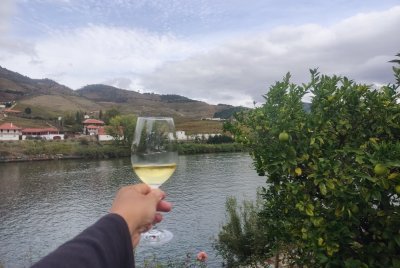
I visited the Douro valley on the 18th and 19th of oct.2024.On the 18th I took the train from Porto-Campanha to Pinhao at 7:25, where I arrived a little late at around 10:00. At 10.30 I had a 2 hour trip with the rebelo boat of the magnifico douro company upriver to Tua and back to Pinhao. Nice,but nothing special. Afterwards I strolled across the Pinhao bridge and entered the Quinta das Carvalhas, where I took part in a wine tasting of white wines; not a single one of the white wines appealed to me.I had been to Porto/Vila Nova de Gaia several times and had already taken part in 3 wine tastings at various Porto houses, so this time I preferred white wine. Disappointing! I had another Porto wine, but it didn't really convince me either. Afterwards I wandered around Pinhao for about an hour. At 4:40 p.m. I took the train to Pocinho, where I arrived around 5:30 p.m. The train route between Porto and Regua is quite boring, the one between Regua and Pinhao is much more interesting, but the one between Pinhao and Pocinho was certainly the highlight of my entire Douro valley visit.I had planned to walk or hitchhike from Pocinho station to Vila Nova de Foz; there were no taxis at the train station.However, I was lucky, after about 300 meters walking towards Vila Nova de Foz a taxi came towards me, so I stopped it and it took me to the youth hostel …
Keep reading 0 comments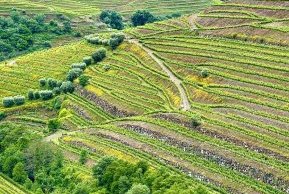
Alto Duoro, from my experience on visiting countless European UNESCO listed vineyards, is probably the best of its kind. The inspiring views of endless beautiful steeply sloping vineyards on endless mountains along the Duoro River valley really show its superlative of its long history of manmade landscape for viticulture. From Porto, we drove to Sao Leonardo de Galafura for its famous viewpoint. Duoro Valley welcomed us with heavy rain and thunderstorm, we thought that Bacchus already cursed us since we could not find any outstanding wine for the past couples of days in Porto and Coimbra. Luckily that when we reached the viewpoint, the rain stopped, and we could admire the breathtaking view of the Douro valley, a perfect start for wine hunting day.
From Sao Leonardo de Galafura we took a hilly road to Peso de Regua, along the way was magnificent view of the sea of mountain vineyards, small villages and modern highway, the whole landscape was impressive of how natural environment has been transformed by 2000 years of wine industry. Quinta da Pacheca is the first Quinta of the day, while the view from this Quinta was just fine, the wine was superb, and we felt that our curse on wine was lifted by Bacchus. Then we continued along the riverside road to Pinhao. The Duoro became more majestic behind river dam, Barragem da Regua, tempting us to stop at few more Quintas, Branco, Popa and Tedo. The best one along …
Keep reading 0 comments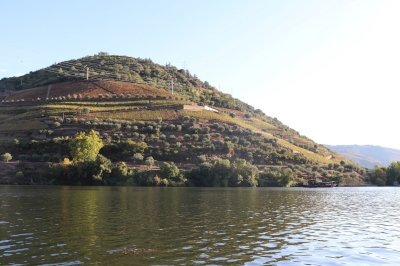
October 2020 - our original plan was to discover the alto Douro by train. We arrived at pocinho station but that day no train would go. No trainride, no rockart tours, the region is modest in its beauty, so we decided to continue by camper. The road to pinhao is extremely windy, we had to make some stops especially for our daughter to t***w up. Close to arriving at the Douro, the slopes were stuffed with wineyards. And in between sign of famous Portwine producers. We were a few weeks to late, most grapes had been harvested. But the scenery along the Douro was beautiful. We made a short boattrip eastwards and got to see the unspoiled part of the wine valley. Regarding Pinhao, we expected a cozy little village in between vinyards. That was not really the case, but the Quinta da Foz at the river offers nice atmosphere and wine. Next day we drove westwards along the river. Way too populated, lack of historic sights, rather a downer. To experience Portwine, Villa Nova de Gaia might be the more interesting Spot.
Keep reading 0 comments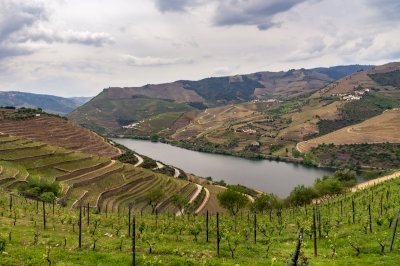
Alto Douro is the part of the river valley where natural conditions conspired to create a unique environment for wine production that dates back over 2,000 years. Fortified wine – the port – may be the signature product, but various kinds of table wine have been becoming more prominent since about the middle of the last century. My affinity for wine notwithstanding, I have never before managed a visit to a WHS that would actually revolve around wine. So, the trip to Alto Douro was the first of a kind for me: primarily a wine-tasting trip that was also a qualified WH visit.
The stretch of the river between the towns of Peso da Régua and Pinhão is the heart of the region, possessing both the most dramatic landscapes and the highest concentration of wineries (called quintas in Portuguese). We planned our time around driving along that stretch (less than 30 kilometers in length), with several targeted stops for exploring and taking in the scenery.
Régua is worth stopping in for the Museum of Douro, a very thorough – without being overwhelming – overview of both the history and the modern process of winemaking in the region. On an intraday visit to the area, you may want to limit your time here to an hour or so, which will allow for a fairly cursory look at the majority of the exhibits. An entrance ticket entitles you to a glass of port in the museum shop at the end …
Keep reading 0 comments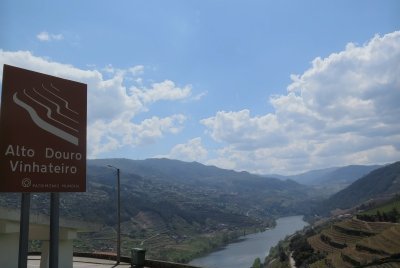
Another wine valley...but wine valleys are beautiful! I will not get into the "unique" or whatnot aspect because it has already been touched by other reviews. I personally enjoyed driving through the section of Peso de Régua to Pinhão and back, stopping for pictures along the way and buying a bottle of wine from one of the many vineyards. I am no wine expert to know which is a good year or which of the vineyards are supposed to be one of the better ones and having to drive I obviously did not do a wine tasting. All I will say is that the wine was well received as a gift.
Keep reading 0 comments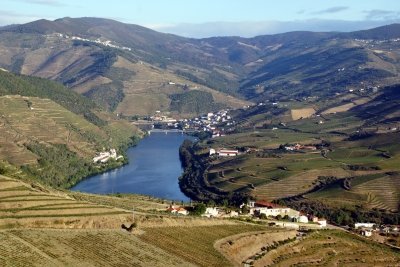
Vineyards are not the most popular type of WHS among the community of this website. One reason is certainly that they belong to an over-represented category. Our vineyards connection comprises a total of 32 WHS, almost half of which are devoted exclusively or predominantly to viniculture. On the other hand, viniculture is one of the oldest and most traditional agricultural technique. And vineyards are often picturesque landscapes, especially if they are along a winding river. And these qualities are given in the Douro Valley.Alto Douro is the oldest demarcated wine region in the world with a protected designation of origin. The core zone of the WHS covers an area of about 24,000 hectares, a stretch of 80 kilometres along the Douro river from Peso da Régua to the Spanish border with branches to include also the mouths of the tributaries Corgo and Rio Pinhão.
Coming from Guimarães on the N101/N108 I first saw the Douro River in the small village of Rede. This is also the western end of the core zone. A few kilometres further on is Peso da Régua, one of the main towns on the Douro. It is not a particularly pretty town and is not within the core zone, but the Museo Douro is worth a visit. The exhibition is well done and you will learn everything you need to know about this WHS: the history of the area, the nature and geology and the peculiarities of viniculture here, the rock art of the …
Keep reading 0 comments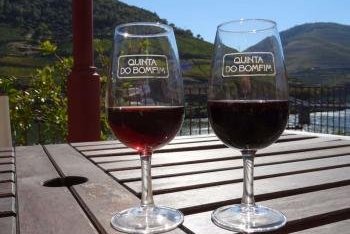
It’s not always easy to convice my wife we need to go to yet another world heritage site but I had no problems when I announced Alto Douro to her. We both love the Porto wines they produce overthere and even she thougt a day of tasting and drinking is not something you skip while being in the area.
The prettiest part of the site lies between the small towns of Pinhao and Peso da Regua, an area full of quinta’s ( the name the Potugese gave their winehouses) and known tot he locals as Cima Corgo. The town of Pinhao itself is not that special but it has some nice views over the river and surrounding hills full of vines. I your there don’t forget to visit Quinta de Bomfim and it’s exquisit selection of fine wine’s. Among others they produce widely known Ports like Dow’s and Graham’s.
We spent a while on their nice terrace overlooking the whs and had a great sunny afternoon. It even got my girl to tell me that we had finally visited a truely great Unesco monument. And that says a lot. Cheers!
Keep reading 0 comments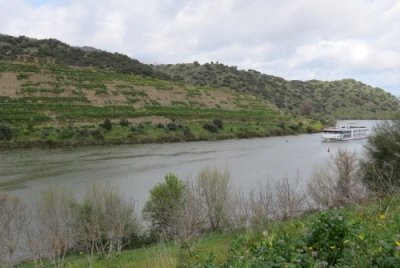
In 2002 I had planned to visit the nearby Coa Valley and had already arranged a tour when they informed me that a visit had become impossible because of flooding. So I limited my tour to the North-East of Portugal to the Douro Valley. There's a nauseating road that follows the Douro River. The towns there looked really rundown. And because it was winter there was not much to see of the wine too.
On my second attempt at the Coa Valley (this time successful), I once again passed the Douro Valley. The areas of these 2 WHS are nearly contiguous. This time I did not take the winding road along the Douro, but the main highway. Numerous signs point to the Douro vineyard landscape.
The landscape is very pretty at times. But it's a pity that you can only speed by. There are hardly any parking spots or lookouts along the way.
Keep reading 0 comments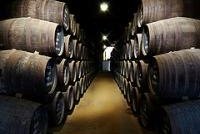
I visited this WHS in August 2014. The first glimpse and enriching experience was by car after having visited the Coa Valley. There were street signs indicating the area inscribed as a WHS and several winding roads that lead to the terraced vineyards. Plenty of grapes on the vines when I visited. Then I enjoyed the captivating views of the Alto Douro valley from the Douro itself on board a boat tour I booked from Oporto. This is definitely a more relaxing experience but I must say that visiting by car on the whole was my favourite experience of the two. To wrap up I decided to visit Graham's cellars at Vila Nova de Gaia to taste the Alto Douro produce and learn about the history of Port-making. Bliss!
Keep reading 0 comments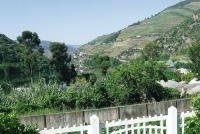
I found the most relaxing way of visiting the Alto Douro was to take the train from Porto to Pocinho and back. The train runs up the valley with excellent views of the rocky gorges, the vinyards and wineries.
Keep reading 0 comments
Portugal is a small country but its landscape changes a lot going from north to the south, changing from green to yellow during the summer. This is due to the large number of rivers in the northern region when compared with the southern one and also due to the amount of water that flows in these rivers. Douro river comes from Spain and since it touches Portugal, in a region that it is the frontier between Spain and Portugal (International Douro park), it passes along the most impressive scenery that I know for a river. However, its rapids disappear due to several dams. Fortunately, most of them permit that boats pass through. The deep valleys are amazing. When the park finishes, two Unesco's World Heritage sites appear. These are the Rockart sites of the Coa valley (an affluent of Douro river) and the Douro Wine Region. These two sites may be visited from (O)Porto, 2nd largest city in Portugal, taking a train or a boat (cruise). Douro Wine Region is the oldest marked wine region and it is the mother region of Port and Douro wines.
Keep reading 0 comments
